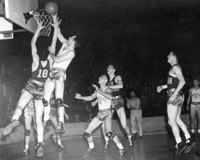NCAA News Archive - 2006
« back to 2006 | Back to NCAA News Archive Index
Oregon’s ‘Tall Firs’ sped their way to the first NCAA basketball title
|
The NCAA News
On
The first title game featured the
A sell-out crowd of 5,500 packed the arena during
The NCAA — at the time an association with no paid staff — agreed to cover the financial losses in exchange for sponsoring future tournaments. That turned out to be a pretty good deal. Today, the Division I Men’s Basketball Championship, anchored by the Final Four, is the centerpiece of an 11-year, $6 billion television rights package with CBS.
It all began modestly in 1939. There was no Final Four back then; only
A particular point of pride for coach Howard Hobson was that he and all of the five starters were born in
The Ducks featured a lineup of 6-8 center Urgel “Slim” Wintermute, 6-4 forwards Laddie Gale and John Dick, and fiery guards Bobby Anet and Wallace Johansen.
Hobson is quoted in the book “The Final Four” about how he wanted his team to compete. “Our fast break was a little unusual in that we looked for it on every possession,” he said. “We used it all the time until the opportunity closed.”
Hobson was also a noted strategist. In the Western playoff final against the
Later he switched to a man-to-man, but he instructed his players to keep their hands high all the time to create the illusion of being in a zone. The ploy confounded
When they arrived home by train days later, they were met by thousands of students and fans. They also took the trophy to a jeweler to mend it into one piece.
From that inauspicious beginning, the NCAA tournament grew to become one of the elite events in American sports. The “Final Two” of 1939 became a “Final Four” in 1952 in
The bracket expanded to 32, then 40, then 48, then 64 and then 64 with a play-in. Larry Bird and Magic Johnson headlined a 1979 national championship game that attracted a television rating of 24.1, still the gold standard for NCAA championship viewership.
In 1982, the Final Four was held in
“It was nerve-wracking,” said Dave Gavitt, a member of the Division I Men’s Basketball Committee chair from 1979-84 and former Big East Conference commissioner. “We were hesitant to leave the conventional buildings because of all the atmosphere. But the demand for tickets (especially from the four participating institutions) was so great we really felt we needed to at least explore sharing this event with more people. We took seven trips as a committee to just walk the arena. We offered to refund anybody’s money. There were only about seven tickets returned.”
In that 1982 final, a crowd of 61,612 watched in the Superdome as the
The public liked what it saw. Finals Fours in Domes became the norm and then the requirement.
These days, prospective improvements focus on such features as in-venue radio broadcasting (the ability to hear home radio calls of the teams involved) or ways of channeling additional information through the use of technology. The constant quest is to improve the experience for student-athletes and fans.
“It is forever a work in progress,” said Greg Shaheen, NCAA vice president of Division I men’s basketball and championship strategies. “And every off-season is spent contemplating how to make it a better experience.”
And it all began modestly in a campus gymnasium 67 years ago.

© 2010 The National Collegiate Athletic Association
Terms and Conditions | Privacy Policy

